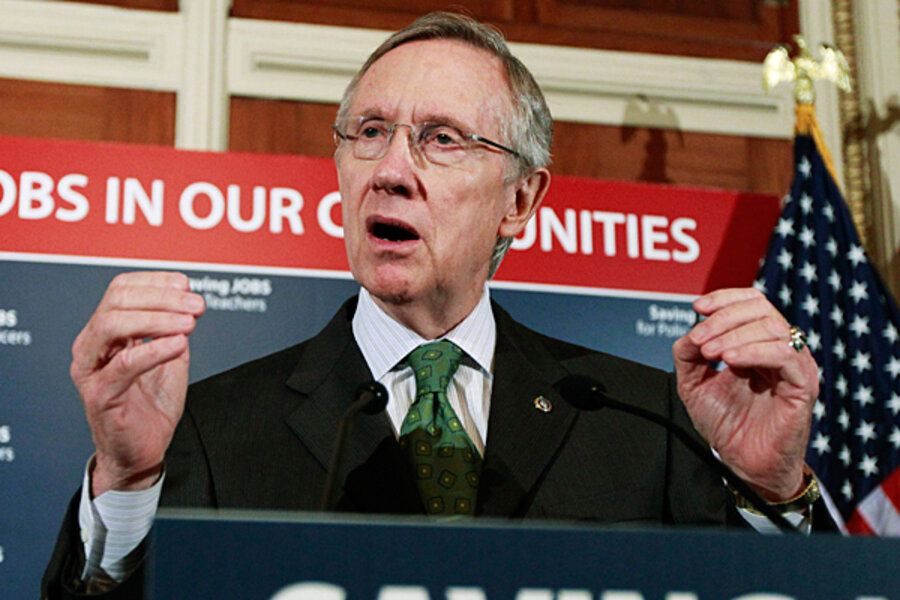Senate approves funding to keep 140,000 teachers' jobs
Loading...
It’s like the ultimate back-to-school gift card: $10 billion for cash-strapped school districts to recall laid-off teachers and keep thousands of K-12 jobs
Supporters of the extra funding say it will keep about 140,000 educators working. The money for teachers, which is part of an aviation safety bill, was approved by the Senate Thursday and will likely pass the House next week when representatives unexpectedly return from August recess.
The infusion of cash could save half the jobs that school districts were expected to have to trim, according to a June survey by the American Association of School Administrators (AASA). Seven out of 10 jobs saved are expected to be teaching positions.
It will be “a welcome infusion of money when people are in pretty desperate financial shape,” says Jeff Simering, legislative director for Council of the Great City Schools, a coalition of 66 large urban districts.
Some districts will be able to find out how much money should be coming their way before the school year starts, he says, while others could use the funds to adjust class sizes during the early weeks when enrollment numbers at each school typically become clear.
Along with money for education, the amendment that’s attached to the aviation bill would also channel $16 billion to states to help pay for Medicaid, an expense that often prompts budget cuts in other areas.
In the original stimulus package, education received more than $100 billion to be spent by the end of this coming school year.
Portions of that money have saved more than 300,000 education jobs, the US Department of Education estimates, based on quarterly reports from the states. An independent statistical analysis found similar figures: 342,000 jobs, or 5.5 percent of K-12 employment, were funded by the stimulus, the Center on Reinventing Public Education reported in March.
Most of those jobs would be wiped out this year by further declines in state and local education funding if Congress doesn’t pass the new bill, says AASA executive director Dan Domenech.
Given the hard economic choices that institutions and individuals are facing these days, that wouldn’t necessarily be a bad thing, critics of the bill say.
“At a minimum [Congress should] use it as an opportunity to encourage [and] provide cover for states to start getting their fiscal houses in order in terms of education spending,” says Frederick Hess, director of education policy studies at the American Enterprise Institute. States could be required to reform costly pension and health-care structures, and districts could be required to report on their cost-effectiveness, he suggests. “Instead, what they’ve said is, ‘Hey, if you complain enough, here’s $10 billion: Spend it now, we’ll worry about the future later.’ "
But drastic state budget cuts mean schools are running out of options, Domenech says. “Everybody has been tightening their belts,” by cutting back on energy, making transportation more efficient, and even going to a four-day week in hundreds of districts. Now cuts will go to the bone – the teaching staff, he says. “It’s important to have small class sizes to deal with the needs of children at risk.”
Democratic lawmakers have been pushing for additional education stimulus dollars since last December, and at one point said $23 billion was needed to prevent massive layoffs. Earlier versions would have paid for the jobs funding by adding to the deficit, or by trimming from money already promised for education-reform initiatives through Race to the Top and other competitive grants. The latter idea fell apart when President Obama, in defense of such reforms, threatened a veto.
The current bill would be paid for by ending an expansion of food-stamp funding in 2014 and by reducing tax credits for multinational companies.
During Senate debate earlier this week, Republican leader Mitch McConnell of Kentucky called the bill “a last-minute effort by Democrats in Washington to funnel more money to the public employee unions before an election.”
But moderate Republicans Olympia Snowe and Susan Collins of Maine voted with Democrats to end a filibuster and allow the bill to move forward for Thursday's Senate vote of 61-39.
House Speaker Nancy Pelosi called on representatives to return from August recess next week to vote on the measure and send it to President Obama, who supports it.
“This investment will save jobs and help prevent districts from shortening the school year, increasing class sizes, and closing libraries in the wake of horrific and damaging budget cuts,” said Rep. George Miller (D) of California, chair of the House committee that oversees education, in a statement today. “While this latest round of funding isn’t enough to avert all layoffs, it is a critical investment in our children and in our future.”
The education money would be distributed to states and districts based on population figures, the proportion of low-income students, and other existing education funding formulae. Preliminary estimates by the Department of Education show amounts ranging from $17.5 million for Wyoming to $1.2 billion to save 13,500 jobs in California.
Related:





